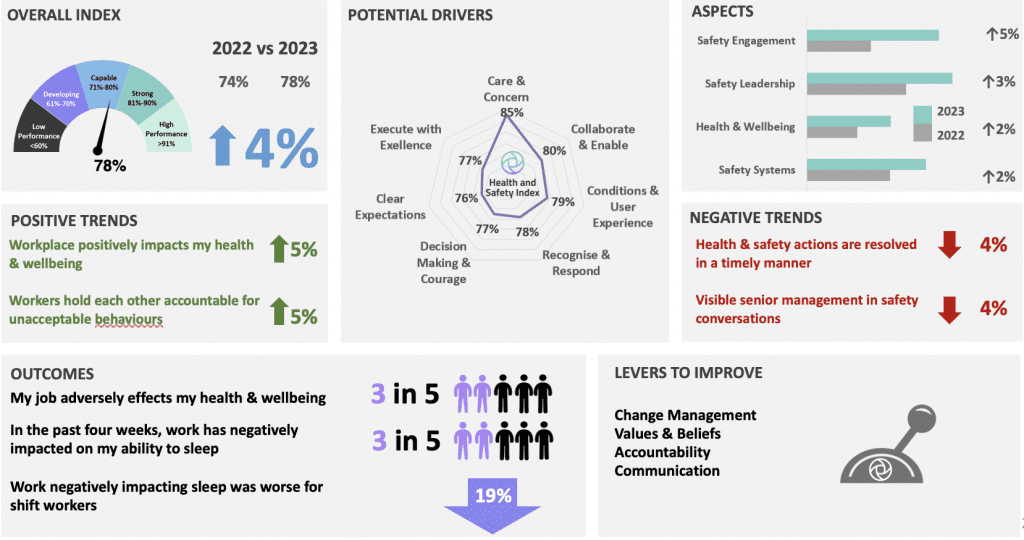Overview
Do you often stop to reflect on the driving force behind your company’s decisions and how to assess their effectiveness?
Each year, the Health and Safety Index meticulously analyses benchmark data which allows us to identify unveiling emerging trends, spotlighting potential concerns, and extracting invaluable insights to enrich our collective knowledge.
Just like a car needs regular servicing for smooth operation, your business requires periodic check-ups to uncover blind spots in specific areas and proactively implement measures for continuous improvement.
Enter our Health and Safety Index tool which is an intuitive online survey crafted to empower organisations in measuring their performance, pinpointing areas for enhancement, and strategically taking actions to effect positive change in safety performance.
Below we explore the 2023 trends to be considered when developing your next strategy. Our goal is to provide this information for a safer, healthier future in the industry!
Benchmarks 2022 vs 2023
The overall Health and Safety Index results from 2022 vs 2023 was 74% or “capable“. This is a significant improvement of 4% compared to the relatively stable 1% increase from the previous years. Notwithstanding this, there were specific areas that had much larger shifts, and we continued to see certain trends continue year-on-year from 2020, affecting overall safety performance.
Of our four Aspects, Health & Wellbeing continues to be the lowest-scoring aspect.

Positive Industry Trends
- Workplace positively impacts my health & wellbeing. ^5% improvement
- Workers hold each other accountable for unacceptable behaviors. ^5% improvement
Improvements in workplace health and wellbeing can be achieved through the establishment of a strong safety culture, clear health and safety information, comprehensive safety training, and effective leadership. By encouraging employees to support each other, maintain open communication, and reporting concerns contributes to a positive workplace environment that values wellbeing and mutual accountability.
Negative Industry Trends
- Health & safety actions are resolved in a timely manner. 4% poorer result
Health and safety actions may be delayed due to resource constraints, a lack of priority, and communication issues. To address this, organisations can allocate adequate resources (refer to our blog on Business Process Outsourcing for HSE professionals) for safety management, prioritise safety as a core value, and improve safety communication channels to ensure timely reporting and resolution of safety actions.
- Visible senior management in safety conversations. 4% poorer result
The lack of visible senior management in safety conversations can result from competing priorities, a perceived lower value of safety discussions and insufficient awareness of their due diligence. To address this, organisations can provide safety training and education to senior managers about the impact of their involvement in health and safety culture and establish clear expectations for their engagement in safety initiatives. Building a robust safety culture that emphasises leadership commitment and accountability can encourage senior management to actively participate in safety conversations.
Mental Health & Wellbeing Outcomes: 19% down
- My job adversely affects my health & wellbeing
- In the past four weeks, work has negatively impacted on my ability to sleep
- Work negatively impacting sleep was worse for shift workers
‘Adverse effect of job on health and wellbeing’ improved ↑ 4%
However, at 50%, ‘Adverse effect of job on health and wellbeing’ was still the poorest result among the 55 health and safety index questions.

Focus Group: shift workers vs non-shift workers
When analysing benchmark data, it’s crucial to evaluate its effects not only on individual mental well-being but also on workplace culture as a whole. Shift workers often constitute the minority in most organisations, and it’s noteworthy that Health and Safety Index results, a key safety data metric, consistently indicate lower scores for this demographic.

Moreover, a notable contrast exists in terms of sleep quality between shift workers and non-shift workers:
“In the last four weeks, work has negatively impacted on my ability to sleep”.
- Shift workers at 39%
- Non-shift workers at 58%

Levers for Action
The Health and Safety Index has been designed to provide ‘Levers’ for action. We provide approximately 12 possible levers for action to provide guidance on strategic choices.
Based on our 2023 benchmark data analysis, we recommend four core areas to improve Health & Wellbeing in the workplace.
- Accountability: Ensure there is a culture of self-regulation to continually improve, e.g., organisational accountability and empowering colleagues to hold each other accountable.
- Change Management: Create operational readiness, capacity, and capability when things are modified or altered to reduce the uncertainty of risk, e.g., adapt systems and capability with a remote workforce, remote contractor mobilisation and work from home arrangements.
- Values & Beliefs: Empower your workforce believe in what is important and right that helps to encourage desired actions and behaviors. This also discourages undesired behavior such as bullying and pressure to compromise safety
- Communication: Provide effective consultation, communication, a link between job and company goals, and action resolution in a timely manner.
If you’d like to identify your unknowns and explore strategies for improving safety performance and strategic planning for your oganisation, don’t hesitate to get in touch with us.

